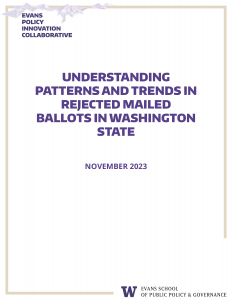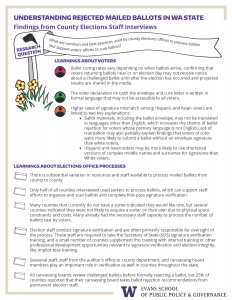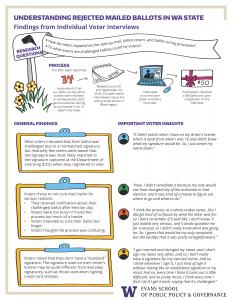Washington State is known for having one of the most effective voting processes in the country, with an efficient mail-in ballot process that provides for wide-spread access to the voting process. However, the February 1, 2022 State Auditor’s analysis of the 2020 Election determined there may be systemic variations occurring due to problems with signature verification. The report indicates disparate rates of signature rejections across Washington counties, namely in rural counties and among communities of color. The Evans Policy Innovation Collaborative (EPIC) is working alongside the Secretary of State’s Office to explore practices noted in the report along with investigating individual voters’ understanding and communication around the signature verification process, and education and outreach methods.
Evans School of Public Policy & Governance
This study poses several research questions to better understand voter experiences with ballot rejection and curing processes:
- How do voters experience the vote-by-mail, ballot return, and ballot curing processes?
- Using longitudinal voter-level and county-level ballot data, how have trends and patterns in ballot rejections varied over time? Do rates of ballot rejections vary by voter demographics or geographic location? How do the reasons for which ballots are rejected vary over time, voter demographics, and geographic location?
- To what extent are challenged ballots cured by voters? How do cure rates vary by voter demographics and geographic location?
- What are common and best practices used by county elections offices to process ballots and support voters’ efforts to cure ballots?
Key study components include:
- Analysis of Ballot Data: The team analyzed voter- and county-level ballot data from the past 10 years of primary and general elections to analyze trends in ballot rejections across the state, with particular attention to variation by age, race, and geography.
- Engagement with County elections Office Staff: The team interviewed county auditors and election staff in Washington State to understand current practices and expenditures around ballot curing and voter outreach as well as offer feasible recommendations based on each county’s unique demographics and resources. The project team also visited several counties in-person to tour and observe office activities during elections.
- Engagement with Voters: The team conducted surveys and interviews with voters in Washington State who had ballots rejected in recent elections to understand their interactions with the curing process.
- Engagement with Community Organizations: The team engaged local and statewide community organizations to understand their work to educate voters about vote-by-mail and ballot curing processes.
- Project Advisory Board: A group of national experts in the field of ballot design, curing, and voter engagement reviewed the study design, commented on analyses, and provided recommendations to reduce the number of rejected ballots in Washington State.
Several key findings emerge about voters’ experiences with vote-by-mail in Washington State:
- From 2012 to 2022, voters in Washington State cast nearly 45 million ballots in primary and general elections.
- Overall, 1.5 percent of all primary ballots cast and 1.1 percent of general election ballots cast were rejected across elections from 2012 to 2022.
- Roughly 25,000 to 35,000 ballots were rejected statewide in each general election since 2012.
- A very small percentage of all ballots cast were rejected for missing a signature or having a signature that does not match what is on file – usually about 0.5 to 0.6 percent of all ballots cast.
- Roughly half of all ballots rejected in primary elections and in many general elections arrive late to county offices.
- There is evidence that voters of color often have higher ballot rejection rates than White voters. For example, Hispanic and Asian voters had ballots rejected at twice the rate of White voters in the 2020 General Election (1.3 percent and 1.2 percent versus 0.6 percent). Black voters experienced ballot rejections in the 2020 General Election at a rate about fifty percent higher than White voters (0.9 percent versus 0.6 percent).
- Self-identifying male voters have slightly higher ballot rejection rates than self-identifying female voters in both primary and general elections.
- Younger voters have a much higher ballot rejection rate than older voters. Nearly 5 percent of voters 18 to 25 years old had ballots rejected in the 2022 general election, compared to 0.8 percent of voters 46 to 65 years old and 0.3 percent of voters 66 or over. Younger voters are much more likely to have ballots rejected due to signature mismatch than older voters.
- In primary and general elections since 2020, about 60 percent of ballots with signature challenges (missing signature or mismatched signature) have been cured before county elections officials submit election results to the State.
The report concludes with recommendations for research, policy, and practice to reduce the number of rejected ballots, increase ballot cure rates, and improve the voter experience in Washington State:
Ballot Envelope Design
- Employ five ballot envelope design principles that would enhance the voter experience:
- Make the text easier to read;
- Use visual cues to draw attention to important information;
- Create space between sections;
- Create a clear layout;
- Put information where voters will find it.
Future Research
- Continue to examine racial and ethnic differences in ballot rejection rates.
- Pursue research collaboration with county elections offices to measure the impact of innovative practices, such as methods of contacting voters, automatic signature verification, modified cure letter formats and methods of verification, or new ballot processing technology.
- Investigate the impact over time of mailed signature update letters on the voter experience.
- Pursue additional research in collaboration with tribal communities to identify obstacles and barriers facing Native American voters in Washington State.
- Fund the work of the Washington State Election Database at the Center for Studies in Demography & Ecology (CSDE) at the University of Washington.
- Test to evaluate areas impacting voters such as timing and methods of ballot cure notices, local contexts like drop boxes and competitive elections, and signature quality across platforms.
A Stronger Role for Community-based Organizations
- Encourage community-based organizations to encourage voters to return ballots early and help voters learn about ballot processing and signature verification.
Strengthening Elections Administration Practice
- Provide greater state funding for county ballot processing technology.
- Provide state support to ensure all county elections websites provide standard information, translated materials, and links to ballot-tracking features of VoteWA.
- Invest in regular peer learning and engagement activities for county elections staff and external groups to share innovative practices and elections administration solutions.
- Develop statewide outreach or educational programs to inform voters about the signature verification process.
- Encourage county elections offices to offer voters regular opportunities to provided updated signatures.
- Create intentional partnerships with community-based organizations that work within historically marginalized communities more likely to have their ballot rejected.
- Provide additional signature verification trainings for county elections staff and modify current signature verification trainings to ensure positive framing.
State Elections Law and Regulation
- Update standards for ballot envelope design and ballot cure notices statewide to ensure they contain language that is easy to understand across all reading levels and for voters who prefer voting materials in a language other than English.
- Move towards greater standardization of county administrative processes pertaining to signature verification and ballot curing.
- Invite voters to provide self-reported race and ethnic identity at the time of voter registration.
- Explore the extent to which ballot drop boxes could be enhanced to prevent missing signatures.
- Scott W. Allard
- Cali Jahn
- Keala Aronowitz
- Megan Ming Francis
- Will von Geldern
- Jessika Gill
- Jake Grumbach
- AK Sterling
- Joshua Varela
- Isaiah Wright
General inquiries about the project may be addressed to: evansepic@uw.edu.


